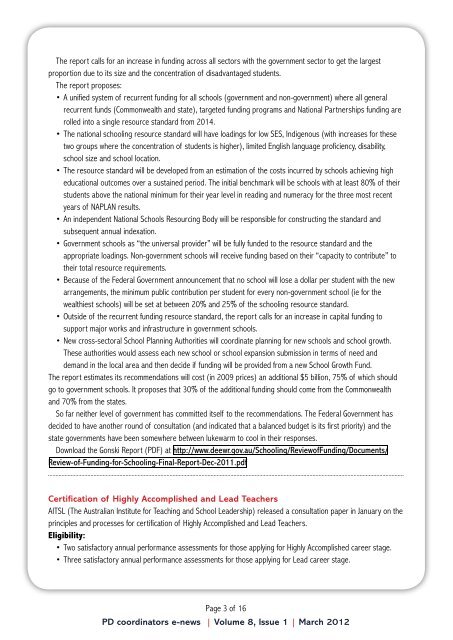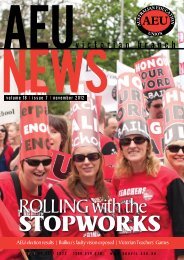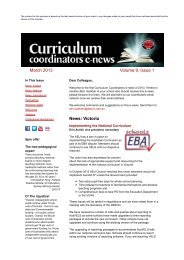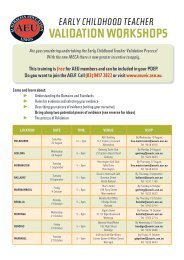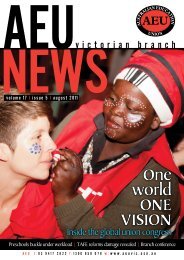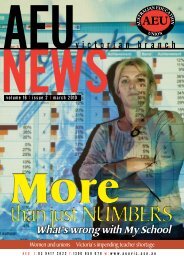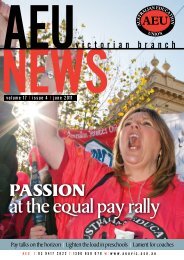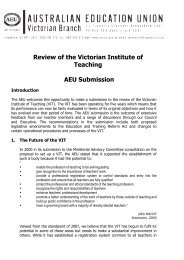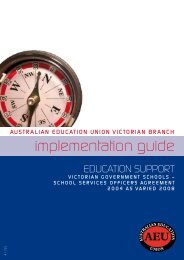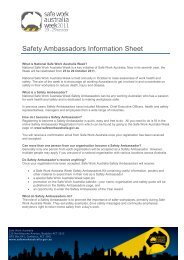PD Coordinators News - Australian Education Union, Victorian Branch
PD Coordinators News - Australian Education Union, Victorian Branch
PD Coordinators News - Australian Education Union, Victorian Branch
- No tags were found...
You also want an ePaper? Increase the reach of your titles
YUMPU automatically turns print PDFs into web optimized ePapers that Google loves.
The report calls for an increase in funding across all sectors with the government sector to get the largestproportion due to its size and the concentration of disadvantaged students.The report proposes:• A unified system of recurrent funding for all schools (government and non-government) where all generalrecurrent funds (Commonwealth and state), targeted funding programs and National Partnerships funding arerolled into a single resource standard from 2014.• The national schooling resource standard will have loadings for low SES, Indigenous (with increases for thesetwo groups where the concentration of students is higher), limited English language proficiency, disability,school size and school location.• The resource standard will be developed from an estimation of the costs incurred by schools achieving higheducational outcomes over a sustained period. The initial benchmark will be schools with at least 80% of theirstudents above the national minimum for their year level in reading and numeracy for the three most recentyears of NAPLAN results.• An independent National Schools Resourcing Body will be responsible for constructing the standard andsubsequent annual indexation.• Government schools as “the universal provider” will be fully funded to the resource standard and theappropriate loadings. Non-government schools will receive funding based on their “capacity to contribute” totheir total resource requirements.• Because of the Federal Government announcement that no school will lose a dollar per student with the newarrangements, the minimum public contribution per student for every non-government school (ie for thewealthiest schools) will be set at between 20% and 25% of the schooling resource standard.• Outside of the recurrent funding resource standard, the report calls for an increase in capital funding tosupport major works and infrastructure in government schools.• New cross-sectoral School Planning Authorities will coordinate planning for new schools and school growth.These authorities would assess each new school or school expansion submission in terms of need anddemand in the local area and then decide if funding will be provided from a new School Growth Fund.The report estimates its recommendations will cost (in 2009 prices) an additional $5 billion, 75% of which shouldgo to government schools. It proposes that 30% of the additional funding should come from the Commonwealthand 70% from the states.So far neither level of government has committed itself to the recommendations. The Federal Government hasdecided to have another round of consultation (and indicated that a balanced budget is its first priority) and thestate governments have been somewhere between lukewarm to cool in their responses.Download the Gonski Report (<strong>PD</strong>F) at http://www.deewr.gov.au/Schooling/ReviewofFunding/Documents/Review-of-Funding-for-Schooling-Final-Report-Dec-2011.pdfCertification of Highly Accomplished and Lead TeachersAITSL (The <strong>Australian</strong> Institute for Teaching and School Leadership) released a consultation paper in January on theprinciples and processes for certification of Highly Accomplished and Lead Teachers.Eligibility:• Two satisfactory annual performance assessments for those applying for Highly Accomplished career stage.• Three satisfactory annual performance assessments for those applying for Lead career stage.Page 3 of 16<strong>PD</strong> coordinators e-news | Volume 8, Issue 1 | March 2012


